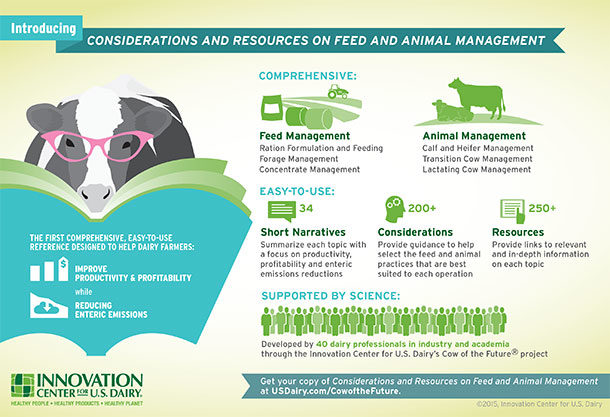A comprehensive new resource on feed and animal management is now available for farmers, veterinarians, nutritionists, dairy science educators and other farm experts and advisers. Considerations & Resources on Feed and Animal Management is the first report to consolidate and synthesize practical information on animal and feed management that improves productivity and profitability while reducing enteric emissions.
The report provides considerations on 34 topics to help dairy farmers and dairy professionals find feed and animal practices that are best suited for their operation.
The considerations are supported by existing science with direct hyperlinks to hundreds of relevant online resources vetted by the authors. Only practices that have the potential to improve productivity and profitability while reducing enteric emissions are included.
The report was developed by the Innovation Center for U.S. Dairy Cow of the Future program with guidance from 40 academic and industry dairy professionals and support from the David and Lucile Packard Foundation.
“Every dairy farm across the U.S. is different, but I believe all of them have a common goal: to take steps toward becoming more efficient and profitable,” says Steve Maddox of Maddox Dairy, who served on the advisory group. “The good news is that increasing feed efficiency is not only good for business; it’s good for the environment.”
The Cow of the Future project focuses on consumer-acceptable technologies that reduce enteric emissions while increasing production efficiencies and dairy farm profitability with the long-term goal to grow dairy sales and enhance consumer trust.
Enteric emissions are the single largest source of greenhouse gas emissions in the milk value chain, and consumers are increasingly demanding products that minimize environmental impact.
Changes to feed and animal management practices have helped us reduce our carbon footprint by 63 percent since 1944, and adoption of practices included in Considerations and Resources will help the industry continue to make progress toward its voluntary goal to reduce emissions by 25 percent by 2020. PD
Resources
Read or download a copy of the Considerations and Resources report. It includes links to 257 resources that were selected from a comprehensive list of journal articles, conference proceedings, practice standards, extension publications and websites.
Test your answer:
What is the benefit to farmers of reducing enteric methane emissions?
ANSWER: Feed and animal management practices that reduce enteric emissions also provide great potential to increase milk yields and improve nutrient-use efficiency.
Your Dairy Checkoff in Action – The following update is provided by the Innovation Center for U.S. Dairy, which was established under the leadership of dairy producers to align the collective resources of the industry against common priorities. The Innovation Center is staffed by Dairy Management Inc™.

Co-op spotlight
Fabian Bernal, B.S., M.S.
Manager of Dairy Production
Dairy Farmers of America

How can using this report help your dairy farmers?
This report connects farmers to the newest and most progressive information that can positively impact their bottom line and future business. DFA’s newly released Milk Quality Specialist Program uses this report as the basis for our farm advisers training program.
Each chapter is used as a primer for in-depth discussions on our topics of interest. We also use the resources provided in the report alongside other documents and articles we selected from the literature.
The Considerations and Resources report is also a preferred source of information for the Mideast region of DFA’s Field Service Program to provide farm support. It is important to take advantage of the educational opportunity provided by this report all across the industry with the goal of improving farm performance and profitability while reducing milk’s environmental footprint.

Why is managing emissions important?
Enteric methane emissions are now generally understood by farmers as an energy loss, and many best practices are currently utilized. However, it is critical to take advantage of new technologies and information in order to reach our target enteric emission reduction goals.
Having an educational tool like this report at the tip of our fingers is invaluable to help us access the most current information available that can help us achieve our sustainability goals.

What does this report do that other resources don’t?
Many current and potential mitigation strategies have been evaluated, but not all of them can be applied at the farm level. Also, in many cases the potential costs associated with mitigation strategies are prohibitive, and the strategies are not fully developed.
This report provides cost-effective strategies that improve productivity, and these strategies have a greater chance of being adopted by dairy producers and recommended by their advisers. PD




